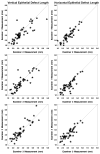Precision of Epithelial Defect Measurements
- PMID: 28129296
- PMCID: PMC5517027
- DOI: 10.1097/ICO.0000000000001148
Precision of Epithelial Defect Measurements
Abstract
Purpose: To ensure optimal care of patients, cornea specialists measure corneal features, including epithelial defects (ED), with slit-lamp calipers. However, caliper measurements are subject to interphysician variability. We examined the extent of variability in ED measurements between cornea specialists and discuss the potential clinical impact.
Methods: A total of 48 variably sized EDs were created in pig eyes. Three cornea specialists measured the maximum vertical and horizontal ED lengths to the nearest 10th of a millimeter using slit-lamp microscopy. An absolute difference in ED measurement between cornea specialists of 0.5 mm was chosen to be the a priori threshold for clinical significance and was evaluated by the Wilcoxon signed-rank test. Interrater reliability was assessed by intraclass correlation coefficients.
Results: The average absolute difference in the vertical ED length between pairs of examiners ranged from 0.54 to 0.63 mm, and that of the horizontal ED length ranged from 0.44 to 0.46 mm. These differences in ED measurement were not significantly different from 0.5 mm (all P > 0.06). However, pairs of examiners differed in vertical ED length measurements by >0.5 mm in 44% to 52% of EDs and by >1.0 mm in 13% to 17% of EDs. Pairs of examiners differed in horizontal ED length measurements by >0.5 mm in 31% to 40% of EDs and by >1.0 mm in 10% to 15% of EDs. The intraclass correlation coefficient was 0.85 (95% confidence interval, 0.77-0.91) for vertical and 0.84 (95% confidence interval, 0.74-0.90) for horizontal ED measurements.
Conclusions: Cornea specialists showed good reliability in the measured EDs; however, depending on the threshold for clinical significance, a nontrivial percentage of cases have high interexaminer clinical variability.
Conflict of interest statement
Conflicts of Interest: All other authors have no significant conflicts of interest or sources of funding to report.
Figures


Similar articles
-
Novel Image-Based Analysis for Reduction of Clinician-Dependent Variability in Measurement of the Corneal Ulcer Size.Cornea. 2018 Mar;37(3):331-339. doi: 10.1097/ICO.0000000000001488. Cornea. 2018. PMID: 29256985 Free PMC article.
-
Comparison of central corneal thickness measurements by rotating Scheimpflug camera, ultrasonic pachymetry, and scanning-slit corneal topography.Ophthalmology. 2006 Jun;113(6):937-41. doi: 10.1016/j.ophtha.2006.01.063. Ophthalmology. 2006. PMID: 16751036
-
Multimodal Assessment of Corneal Thinning Using Optical Coherence Tomography, Scheimpflug Imaging, Pachymetry, and Slit-Lamp Examination.Cornea. 2017 Apr;36(4):425-430. doi: 10.1097/ICO.0000000000001151. Cornea. 2017. PMID: 28129300 Free PMC article.
-
Diagnosis of corneal limbal stem cell deficiency.Curr Opin Ophthalmol. 2017 Jul;28(4):355-362. doi: 10.1097/ICU.0000000000000387. Curr Opin Ophthalmol. 2017. PMID: 28426441 Review.
-
Confocal microscopy of the cornea.Prog Retin Eye Res. 1999 Sep;18(5):553-628. doi: 10.1016/s1350-9462(98)00028-7. Prog Retin Eye Res. 1999. PMID: 10438152 Review.
Cited by
-
Use of 'U-shaped tool for follow up of corneal ulcer cases in the COVID-19 pandemic.Indian J Ophthalmol. 2020 Oct;68(10):2199-2201. doi: 10.4103/ijo.IJO_1560_20. Indian J Ophthalmol. 2020. PMID: 32971640 Free PMC article.
-
Open-Source Automatic Biomarker Measurement on Slit-Lamp Photography to Estimate Visual Acuity in Microbial Keratitis.Transl Vis Sci Technol. 2021 Oct 4;10(12):2. doi: 10.1167/tvst.10.12.2. Transl Vis Sci Technol. 2021. PMID: 34605877 Free PMC article.
-
Novel Image-Based Analysis for Reduction of Clinician-Dependent Variability in Measurement of the Corneal Ulcer Size.Cornea. 2018 Mar;37(3):331-339. doi: 10.1097/ICO.0000000000001488. Cornea. 2018. PMID: 29256985 Free PMC article.
-
Open-Source Automatic Segmentation of Ocular Structures and Biomarkers of Microbial Keratitis on Slit-Lamp Photography Images Using Deep Learning.IEEE J Biomed Health Inform. 2021 Jan;25(1):88-99. doi: 10.1109/JBHI.2020.2983549. Epub 2021 Jan 5. IEEE J Biomed Health Inform. 2021. PMID: 32248131 Free PMC article.
-
Algorithm Variability in Quantification of Epithelial Defect Size in Microbial Keratitis Images.Cornea. 2020 May;39(5):628-633. doi: 10.1097/ICO.0000000000002258. Cornea. 2020. PMID: 31977729 Free PMC article.
References
-
- Channa R, Zafar SN, Canner JK, et al. Epidemiology of Eye-Related Emergency Department Visits. JAMA Ophthalmol. 2016;134:312–319. - PubMed
-
- Roper-Hall MJ. Thermal and chemical burns. Trans Ophthalmol Soc U K. 1965;85:631–653. - PubMed
-
- Bonini S, Lambiase A, Rama P, et al. Topical treatment with nerve growth factor for neurotrophic keratitis. Ophthalmology. 2000;107:1347–1352. - PubMed
-
- Sotozono C, Ang LP, Koizumi N, et al. New grading system for the evaluation of chronic ocular manifestations in patients with Stevens-Johnson syndrome. Ophthalmology. 2007;114:1294–1302. - PubMed
Publication types
MeSH terms
Grants and funding
LinkOut - more resources
Full Text Sources
Other Literature Sources
Medical

